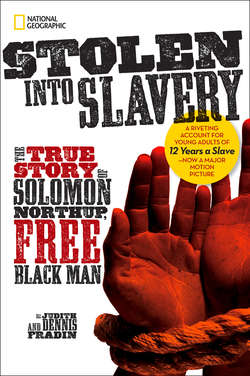Читать книгу Stolen into Slavery: The True Story of Solomon Northup, Free Black Man - National Kids Geographic - Страница 9
(Illustration Credits 1.10)
ОглавлениеSHORTLY AFTER THE ORLEANS DOCKED IN NEW ORLEANS, slave dealer Theophilus Freeman arrived on board. Freeman, who did extensive business with James Birch, had bought Solomon and several other slaves aboard the ship sight unseen. Before taking this human cargo to his slave pen, he called their names and handcuffed them.
When he called out “Platt!” no one stepped forward. Pointing to Solomon, Freeman asked the captain of the Orleans, “Who shipped that nigger?”
“Birch,” replied the captain.
“Your name is Platt—you answer my description,” said Freeman, studying his list. “Why didn’t you come forward?” Solomon honestly answered that he had never been called Platt before. “Well, I will learn you your name!” said Freeman, threatening to whip Solomon if he ever again forgot that his name was Platt.
Along with the other slaves Freeman had purchased, Solomon was led to his new owner’s slave pen. A portion of the pen was a kind of showroom where people shopping for slaves came to look over the merchandise. Freeman’s number one rule was that his slaves must do their best to look “spry and smart” in order to attract buyers and fetch a good price. He even demanded that they dance for customers to show that they were happy to be slaves.
Solomon had been in Freeman’s slave pen a day or two when an elderly gentleman came in. He lived in New Orleans, the gentleman said, and he needed a coachman. Solomon very much wanted the man to buy him, because he figured that New Orleans would offer opportunities for escape. But when Freeman announced that Solomon was selling for $1,500—equal to $40,000 today—the gentleman said that was too much and backed off.
That night Solomon came down with smallpox—the disease that had claimed Robert’s life at sea. He was sent to Charity Hospital on the outskirts of New Orleans, where his condition worsened. He ran a high temperature, suffered from severe body aches, and for three days was completely blind. The doctors believed that Solomon would die, but the thought that he had to live and return to his family went round and round his feverish brain. After 16 days in the hospital he began to recover and was returned to Freeman’s slave pen.
Finally, after weeks of being offered for sale, Solomon was purchased by William Ford, a planter from central Louisiana. Solomon was in such poor condition from his bout with smallpox that his selling price dropped to $900—$600 less than what he would have sold for before he became so seriously ill. He had now been sold three times: by Brown and Hamilton to Birch, by Birch to Freeman, and then by Freeman to Ford.
Slaves generally had no last names of their own but were called by their owners’ last names. Platt Ford, as Solomon Northup was now known, was taken by boat, train, and on foot to William Ford’s plantation. The Ford property was located in the Great Pine Woods. Escape from this vast wooded wilderness in Louisiana’s Red River Valley was nearly impossible. For one thing, the area’s large swamps were home to alligators and poisonous snakes. For another, the nearest “free state”—or state that had outlawed slavery—was 500 miles away.
This is the bill of sale certifying that Theophilus Freeman sold Solomon Northup (called Platt) to William Ford. (Illustration Credits 1.11)
Solomon was put to work chopping tree trunks into logs and making piles of lumber. A skilled carpenter, he also did construction work on the Ford family’s property.
At the time, William Ford was a wealthy cotton planter who owned a number of slaves. One of them was Walton, a house slave who had lived all his life on the Ford plantation and who spoke of Mr. Ford as a child would of his father. Another was John, the Fords’ 16-year-old cook, who walked around chuckling to himself and laughing at things that no one else found funny. However, Solomon felt the most sympathy for Eliza, the young woman who had been in Birch’s slave pen with her two children. When Freeman sold Eliza to William Ford, he sold her son and daughter to other masters. Knowing that she probably would never see her children again, Eliza cried almost continuously.
